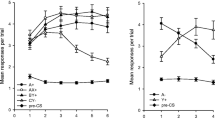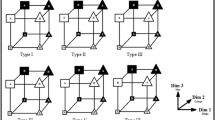Abstract
A general function is derived describing the conditioning of a single stimulus component in a discriminative situation. This function, together with the combinatorial rules of statistical learning theory [5, 12], generates empirically testable formulas for learning of classical two-alternative discriminations, probabilistic discriminations, and discriminations based on the outcomes of preceding trials in partial reinforcement experiments.
Similar content being viewed by others
References
Burke, C. J., Estes, W. K., and Hellyer, S. Rate of verbal conditioning in relation to stimulus variability.J. exp. Psychol., 1954,48, 153–161.
Bush, R. R. and Mosteller, F. A model for stimulus generalization and discrimination.Psychol. Rev., 1951,58, 413–423.
Estes, W. K. Learning. In Annual review of psychology, 1956,7, 1–38.
Estes, W. K. Theory of learning with constant, variable, or contingent probabilities of reinforcement.Psychometrika, 1957,22, 113–132.
Estes, W. K. and Burke, C. J. A theory of stimulus variability in learning.Psychol. Rev., 1953,60, 276–286.
Estes, W. K. and Burke, C. J. Application of a statistical model to simple discrimination learning in human subjects.J. exp. Psychol., 1955,50, 81–88.
Estes, W. K., Burke, C. J., Atkinson, R. C., and Frankmann, J. P. Probabilistic discrimination learning.J. exp. Psychol., 1957, in press.
Estes, W. K. and Straughan, J. H. Analysis of a verbal conditioning situation in terms of statistical learning theory.J. exp. Psychol., 1954,47, 225–234.
Hake, H. W. and Hyman, R. Perception of the statistical structure of a random series of binary symbols.J. exp. Psychol., 1953,45, 64–74.
Neimark, Edith D. Effects of type of non-reinforcement and number of alternative responses in two verbal conditioning situations.J. exp. Psychol., 1956,52, 209–220.
Restle, F. A theory of discrimination learning.Psychol. Rev., 1955,62, 11–19.
Schoeffler, M. S. Probability of response to compounds of discriminated stimuli.J. exp. Psychol., 1954,48, 323–329.
Wyckoff, L. B., Jr. The role of observing responses in discrimination learning.Psychol. Rev., 1952,59, 431–442.
Author information
Authors and Affiliations
Additional information
The researches on which this paper is based were facilitated by a grant from the National Science Foundation.
Rights and permissions
About this article
Cite this article
Burke, C.J., Estes, W.K. A component model for stimulus variables in discrimination learning. Psychometrika 22, 133–145 (1957). https://doi.org/10.1007/BF02289049
Received:
Issue Date:
DOI: https://doi.org/10.1007/BF02289049




